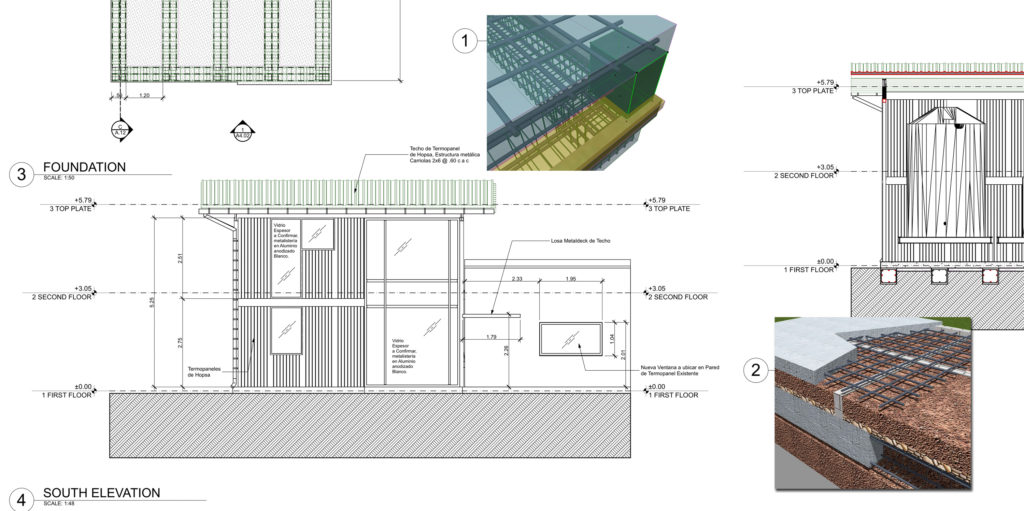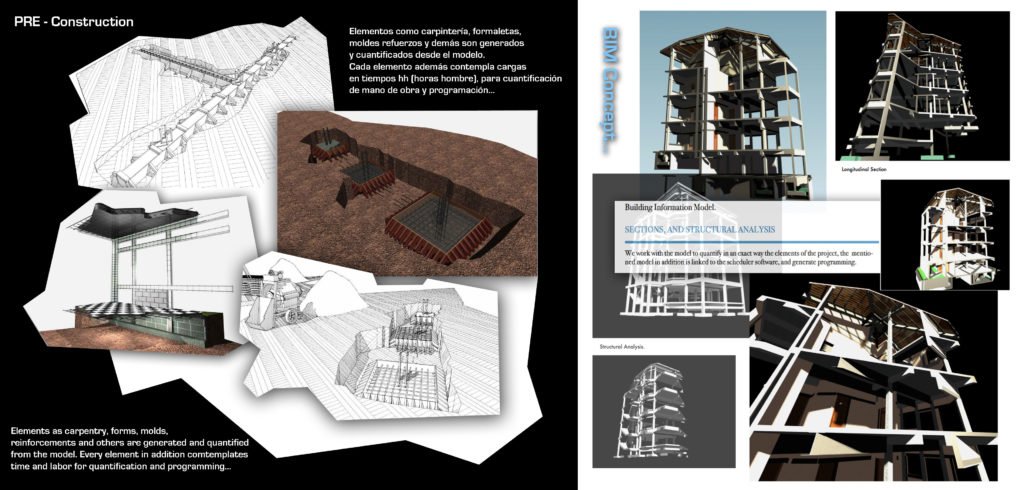– This article was written in 2010, many of its aspects are still relevant –
Intelligent parametric virtual objects modeled via GDL (Geometric Description Language) in IFC (Industry Foundation Classes) format applied in virtual design and construction platforms, managed in integrated project management and adapted to the Construction Industry in Panama.
Real estate projects are subordinated to different variables depending on their scope or objective, some are imperative: design, quantities of material, forecast of purchases, allocation of yields for work budgets; specifications and plans; control of programming, constructability, structural calculations, facilities, risks, security, environmental impact, financial control, acoustics and more recently sustainability, are just some of the aspects. It is essential to achieve a comprehensive work plan whose close and coordinated relationship between the different agents, anticipate failures, solve errors, be efficient. Traditionally, each of the aforementioned variables, as they are related to various specialties, are handled independently, that is, each professional or group works in a practically isolated manner, to then locate their proposal in the general plans or construction documents. The next step is to make the necessary adjustments in the documents according to the limitations, conflicts and changes generated from various reasons (interrelationships, new provisions) this occurs in a sustained way in the planning process and takes a lot of time, as there is no planning tools available. Adequate formulation, even many problems are detected in the execution periods whose negative impact on the project is even more sensitive. Classic problems in traditional project formulation developments in the current market are:
Architecture:
Poor information in construction documents regarding physical and functional characteristics; Two-dimensional construction plans or documents and little updated throughout the life cycle of the project where changes in budget, Schedules in terms of design elements are not reflected safely; very low level of information exchange; incompatibility of software of the different specializations (one of the biggest obstacles in the exchange of information); low interoperability, it is estimated that this problem affects project costs by 3.6%. In engineering: complicated generation of information related to the design of the systems facilities and the analysis of their characteristics, the data generated from these analyzes often generate changes in design affecting budgets and schedule; The information generated as a result of the plumbing, mechanical, air conditioning, electricity and other systems generate rarely detected interferences causing costs and change orders in execution stages.

Construction:
Confusing generation of updated information with field work and related to scheduling, forecasting, necessary quantities (equipment, materials, etc.) these cost directly affects the project design; also, the low interoperability of field control systems with office systems is a great obstacle. 2.5% of the additional costs of a project are linked to this phenomenon. Owners and Investors: poor and inaccurate update on costs, scheduling, and its necessary adjustments throughout the project life cycle, little information related to the maintenance or use of the project facilities. Manufacturers of construction products: lack of information regarding dimensions, weights, appearance, costs, warranties and future maintenance, all these data affect costs and designs. Intelligent virtual objects generated with Virtual Design and Construction methods (VDC methods), with BIM (Building infomation Model) tools or building information models and processed and applied to collaborative management systems are the way, industrialized countries are using for the solution of these problems.
Virtual design and construction technology via BIM is being implemented in the main programs (Allplan®, Archicad®, and Revit® Architecture) and its evolution offers users substantial improvements in the complete development of their projects. The efficiency measured in productivity due to the implementation of these innovative forms of project management has provoked reactions in developed countries, in many the use of virtual systems is required, there are even bills in the United States that are aimed at it (Colorado House Bill 1342 “IPD Methods and Public Projects ̈), and the Wisconsin State Facilities Division will require that all projects larger than 5 million dollars be designed based on Virtual BIM development systems, the American Institute of Architects already includes among its work guides a ̈IPD guide ̈ where a BIM collaboration addendum has been made, giving this a turnaround not only in administration but even in the formation of construction contracts and their legal implications. Rapid application due to the new demands in industrialized countries is a challenge for companies that in these countries are just beginning to manage BIM systems and intelligent objects and face the consequent costs due to learning curves.

The objective is the generation of intelligent virtual objects as integrated collaborative construction tools applied in virtual design and construction processes, this is achieved through various advanced management systems: IPD (Integrated project delivery) or integrated project management, Lean Construction or efficient construction and the aforementioned BIM (Building Information Model) programs or Building Information Model Programs in virtual design and construction platforms, and collaborative agreements that are a new generation of integrated contracts. Success lies in the continuous and expeditious exchange of information from the initial stages of the project. It is necessary in the first instance to achieve a system based on parametric intelligent objects that is sufficiently robust and of efficient interoperability, with this objective objects generated in GDL (Geometric Description Language) are used, which is one of the programming languages used to manufacture the elements. or objects that are managed for the virtual information model of a building, for example, a wall generated in GDL language can contain information on the type of material, labor yields, quantities of blocks, cement, weights, dimensions, costs, time, etc. It can also behave intelligently, that is, it can respond and vary in the face of specific conditions that apply to the project and evaluate results or impacts. New GDL objects are created with information, unit values, specifications, regulations, uses and requirements of the building manufacturing systems in Panama in IFC format, the IFC (Industry Foundation Classes) format is open specification and is not under the control from any software manufacturer. It has been developed by the IAI (International Alliance for Interoperability) in order to become a standard that facilitates interoperability between programs in the construction sector. With this format, the data entry process is simplified and each computer application that intervenes in the project only needs the necessary data entry and the data entered in the CAD / BIM programs can be used, with increased security and reduction consequent effort. Intelligent parametric objects are linked or exported to various programs that handle the different specialties and specific independent models are obtained that we will call discipline models, such as those of analysis and structural design, for example, where the model is subjected to various tests (loads, earthquakes, winds, etc.) to generate the necessary elements for support and adequate construction, the architectural one where the design and availability of spaces are defined, the mechanical one in which the wet systems against fire or air conditioning are developed, the plumbing, systems electrical and others.
All this information is immediately and accurately summarized in smart objects, which will change or adjust to the specific results generated in each of the discipline models, this set of objects generated in these models are finally combined into a single composite model. , which is also altered and adapted according to the requirements generated by the aforementioned discipline models of each of the specialties and also receives constant feedback. In this platform, the composite model also detects errors in relation, location, design, layout, and even further in costs, budget, and scheduled time, since it is susceptible to being affected according to various scenarios and can be connected to sequencers, work or construction control programs or administration and scheduling, energy efficiency, sustainability and environmental impact After the tests of the composite model have been executed and the expected behavior or performance has been achieved, the entire team (owners, engineers, architects, operators, contractors , subcontractors, manufacturers and material suppliers) exchange information in a single view or scenario of the entire project in real time in the later stages of execution, operation or evaluation, where design, planning and programming, supply chain, management, risk management, budgets and costs are synchronized, these stages involve: quantification of quantities for budgets, where they are achieved very precise estimates derived from the information deposited in the GDL objects; budgets, here the different components are assembled according to the cost structures generated in the IFC format from the smart objects and are linked to various performance calculation formulas that can be achieved according to the standards of the Panamanian Chamber of Construction in terms of hand of work and based on the technical requirements, dosages or specifications necessary for each material or equipment, the budget will be redefined due to any change made both in the discipline models and in the compound, affecting values immediately; In the same way, the project time scheduling will behave, since all smart objects also have man-hour loads that will be adjusted according to the availability or desired resource allocation and are linked to time scheduling programs whose flow lines are optimized and compressed. to review feasibility and achieve scenario planning, risk analysis and achieve better predictability, since the database generated in the composite model achieves immediate reports reporting conflicts or problems in any scenario applied to the project and thus make better decisions avoiding delays and errors.

In addition, risk mitigation due to collaborative agreements of the work team applied to Efficient or Lean Construction Methods and BIM strategies encourages all those involved to efficiently solve constructability and design problems as the project progresses, achieving a high degree of efficiency throughout the construction process. These tools and processes carried out from virtual models oblige those involved to mitigate a particular risk in the best position and at the right time. The integration of all the processes and the improvement in communication throughout the design and construction cycle have proven to be an essential part of the changes that have been generated in the administration of works today, intelligent objects in platforms of construction models. Design and Virtual Construction of the Building and managed in platforms of integrated delivery of projects have proven to be key elements in order to achieve that necessary flow of information and communication. The intelligent parametric virtual objects make up a virtual, predictive-interactive model of the possible scenarios and conflicts within a construction project; This technology allows a greater and accurate understanding by all the professionals involved, since it is presented within the universal visual language managed by all the members of a team from the initial lines of design until the completion of the work.
Arq. Luis Vargas A.
2010-08-27
Panamá, Panamá

